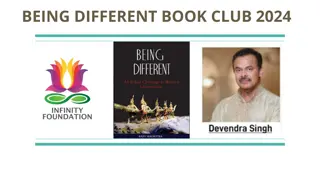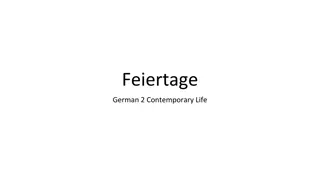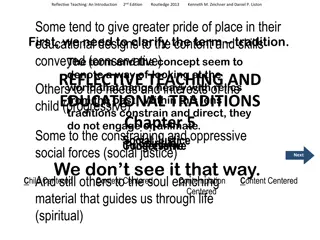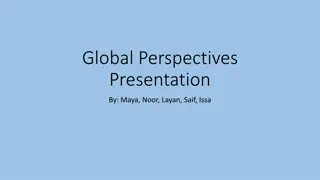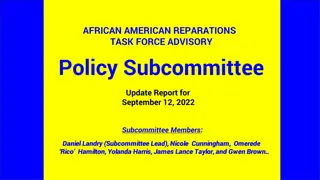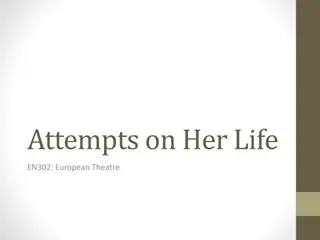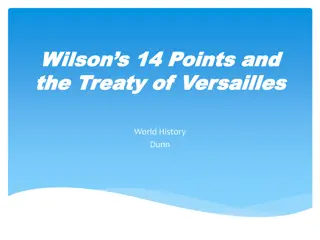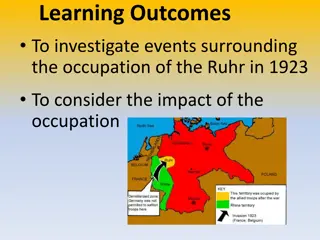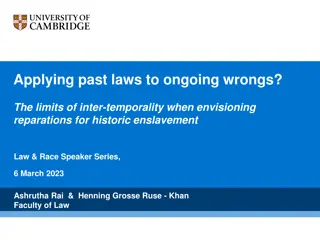Historical Struggles for Reparations: Insights from Different Traditions
Explore the historical context of reparations through different traditions like the indigenous, Black, anti-colonial, African, and more, highlighting significant events such as land grants to Alaskan Natives and compensation for African American farmers. Learn about the ongoing fight for justice and reparations globally.
Download Presentation

Please find below an Image/Link to download the presentation.
The content on the website is provided AS IS for your information and personal use only. It may not be sold, licensed, or shared on other websites without obtaining consent from the author.If you encounter any issues during the download, it is possible that the publisher has removed the file from their server.
You are allowed to download the files provided on this website for personal or commercial use, subject to the condition that they are used lawfully. All files are the property of their respective owners.
The content on the website is provided AS IS for your information and personal use only. It may not be sold, licensed, or shared on other websites without obtaining consent from the author.
E N D
Presentation Transcript
History of reparations DIN Sandew Hira Email: sandew.hira@iisr.nl Tel./Whatsapp: +31 6 412.83.785 1 15-8-2018 AMRIT APPLICATIONS
2001 World Conference against Racism How does Durban fit in the history of the struggle against reparations? Where are we now in this struggle? How to move forward? 2 15-8-2018 AMRIT APPLICATIONS
The long struggleagainstracismand forreparations: the different traditions 1. The indigenous tradition in North America 2. The black tradition in the USA 3. The anti-colonial tradition in the Caribbean 4. The indigenous tradition in Latin America 5. The African tradition 6. The Oceanic tradition 7. The Indian tradition 8. The Chinese tradition 9. The Indonesian tradition 10. The Western Asia tradition 11. The multicultural European tradition 3 15-8-2018 AMRIT APPLICATIONS
1. The indigenous tradition in North America In 1971, the American government granted US $ 1 billion and 44 million acres of land to Alaskan natives. In 2010, the US government settled a longrunning dispute over government mismanagement of Native American lands and accounts for US$ 3.4 billion. In 2010the government of Canada reached an agreement with the Mississaugas of the New Credit First Nation for compensation of a specific land claim for two pieces of land (total 243,450 acres). On the basis of an agreed price per acre and an interest rate the amount was settled at CA $ 145 million The focus is on land: getting land or compensation for stolen land 4 15-8-2018 AMRIT APPLICATIONS
2. The black tradition in the USA During slavery intellectual slaves argues for reparations: Frederick Douglass, Solomon Northrop, Jourdan Anderson: how it feels to be forced to work without payment Forty acres and a mule: a wartime order proclaimed by Union General William Tecumseh Sherman on January 16, 1865, during the American Civil War, to allot land to some freed families, in plots of land no larger than 40 acres (16 ha). Sherman later ordered the army to lend mules for the agrarian reform effort. In 1969 the Black Manifesto was adopted in the National Black Economic Development Conference in Detroit, Michigan. The manifesto called upon White Christian Churches and Jewish Synagogues to pay US $ 500 million for reparations. 1987: National Coalition of Blacks for Reparations in America (N'COBRA). They have nine national commissions: Economic Development, Human Resources, Legal Strategies, Legislation, Information and Media, Membership and Organizational Development, International Affairs, Youth and Education In 2010, the US government agreed to pay US $ 1.2 billion to 15,640 African American farmers as compensation for discrimination. For decades these farmers had been denied loans and assistance from the Agricultural Department although they were entitled to get it. 5 15-8-2018 AMRIT APPLICATIONS
3. The anti-colonialtradition in the Caribbean Haiti: 1825-1947 Haiti paid reparation to France. In 1990, Haiti s first democratically elected president Jean-Bertrand Aristide came to power. In 2003 president Jean-Bertrand Aristide demanded US $ 21.7 billion restitution of reparations. In 2004, he was deposed by a coup supported by France and the USA. He was kidnapped and transported to South Africa Jamaica: In the 1960s, Jamaican Rastafarians began petitioning the British Crown for reparations for slavery to fund their repatriation to Africa, even presenting a petition to the United Nations: US$ 129 billion 2013: CARICOM Heads of Government established the CARICOM Reparations Commission to prepare the case for reparatory justice for the Region's indigenous and African descendant communities 6 15-8-2018 AMRIT APPLICATIONS
4. The indigenous tradition in Latin America Bolivia 2008: Evo Morales demands that industrialized countries pay climate reparations for the devastating effects of CO2 emissions. If there are countries that are doing a lot of damage to the environment, those countries should make some acknowledgment, some reparation for the damages that they are causing. Developed countries should contribute a minimum of 1 percent of their annual GDP to a United Nations fund for poor countries. Brazil 2003: government officially defined a Quilombo community as a self-identified, ethno-racial group with their own historical trajectory, a specific relationship to the land, and the presumption of a black ancestry connected to forms of resistance to historical oppression . The government policy was to grant land title to Afro-Brazilian communities that could demonstrate they were a Quilombo community. 7 15-8-2018 AMRIT APPLICATIONS
5. The African tradition Namibia: Between 1904 and 1908 Germany committed genocide on the Herero people in their former colony in South-West Africa. In 2001 the Herero People s Reparation Corporation filed a law suit against German corporations and another one against the German state, but to no avail. In 2021 Germany offers to fund projects in Namibia worth more than a billion euros ($1.22 billion) over 30 years. In the Belgian Congo black African men were forced to collect rubber. If they did not meet their quota the hands of their wives and children were cut off. The Congolese Holocaust by the Belgians killed 10 million Africans. The King offered apologies, but no reparations. In 2020 Burundi has asked Belgium for reparations for its crimes during the colonial era (1924- 1962, suggesting financial compensation and collaborating on writing colonial history. Germany, which colonised Burundi from 1885 to 1924, was charged with 36 billion for colonial crimes. In 2004, The African Union adopted an Action Plan 2004-2005 with a recommendation on reparations: Debate in all African parliaments on slavery. Objective: declare slavery a crime against humanity and discuss the nature of reparations. In 2009, the then president of the African Union Muammar al-Qadhafi stated in a speech during the 64th Session of the United Nations General Assembly, that Africa deserves reparations, which amounts to US$ 7.77 trillion for the resources and wealth stolen in the past. 8 15-8-2018 AMRIT APPLICATIONS
6. The Oceanic tradition New Zeeland In 1995 the government paid US$ 114 million to the Waikato-Tainui tribal confederation for reparations. In 2008 the government paid another US$ 283 million. In 2019 Maori s called upon the government to return stolen land to the Maori s. In 2021 the Maori community started a petition that calls on Parliament to change New Zealand to Aotearoa and begin a process to identify and officially restore the original M ori names for all towns, cities and places right across the country by 2026. Australia Between 1910 and 1970, government officials here rounded up children of mixed White and Aboriginal and Torres Strait Islander ethnicity, and sent them to boarding schools and church-run missions. In 2021 the government agreed to pay about $280 million in reparations to survivors who were removed from their families. Calls from activists: Stolen Children, Stolen Wages, Stolen Land, Stolen Wealth: Reparations For Aboriginal Australia Since 1998, May 26 is recognized as National Sorry Day to remember and commemorate the mistreatment of the indigenous population. There is a National Sorry Day Committee that has programs for schools across Australia to support teachers who plan events to commemorate National Sorry Day. The National Sorry Day is an annual event of education and reconciliation. 9 15-8-2018 AMRIT APPLICATIONS
7. The Indian tradition 2015 Shashi Tharoor, member of the Indian parliament, held a speech at the Oxford Union that went viral. The speech argued that Britain owes reparations to her former colonies. He suggested that Britain pay one pound sterling per year for the next two centuries as symbolic reparation. Prime Minister Modi supported Tharoor: Tharoor s speech reflected the feelings of patriotic Indians on the issue and showed what impression one can leave with effective arguments by saying the right things at the right place. 2018: Indian economist Utsa Patnaik calculates that Britain drained a total of nearly $45 trillion from India during the period 1765 to 1938. 10 15-8-2018 AMRIT APPLICATIONS
8. The Chinese tradition In China, the British conducted two wars, called the Opium Wars (1839-1842 and 1856-1860) to force the Chinese emperors to allow the British to import narcotics into China and thus addicting millions of Chinese with the devastating drugs. China was forced to pay Britain US$ 21 million (2022 value: US$ 736 million) to cover the cost of the War. China has not asked for restitition as Haiti did. 11 15-8-2018 AMRIT APPLICATIONS
9. The Indonesian tradition On August 17 1945 Soekarno proclaimed Independence of Indonesia from the Dutch colonizers. The Dutch re-invaded Indonesia and a war ensued lasting from 1945-1949, costing 150.000 Indonesian lives. Under American pressure the Dutch withdrew, but demanded and got US$ 3,3 billion (2022: US$ 40 billion) reparations from Indonesia. Activists demand restitution. No action from the Indonesian government. 12 15-8-2018 AMRIT APPLICATIONS
10. The Western Asia tradition In 1990 Iraq invaded and occupied Kuwait. This led to the first Gulf War. The war ended in 1991 with a UN decision that Iraq should pay compensation to individuals and corporations. The UN created the United Nations Compensation Commission (UNCC). Between 1991 and 2005. the UNCC had received 2.7 million claims from individuals, corporations, governments and international organizations. A total amount of US $ 52 billion has been awarded to successful claims. In 2022 Iran demanded compensation for the economic harm it suffered following the Trump administration s withdrawal from the JCPOA (Joint Comprehensive Plan of Action the nuclear deal). 13 15-8-2018 AMRIT APPLICATIONS
11. The multicultural European tradition In England in the early 1990s, MP Bernie Grant founded the African Reparations Movement UK. His work on reparations involved demands that British museums account for the thousands of artifacts they had plundered during imperial conquest, and return to their original owners. 2022: The third-largest Dutch bank, ABN AMRO, has apologised for its involvement in slavery saying the practice in the 18th and 19th centuries caused untold suffering . The bank is one of the first Dutch private companies to apologise for its role in the Atlantic slave trade amid growing debate about a painful period in the Netherlands s colonial past. 14 15-8-2018 AMRIT APPLICATIONS
Where do we stand now afterDurban 2001 1. There is a lot going on in the world regarding reparations! 2. It is very diverse in participation, content and strategies. 3. There is no central coordination. 15 15-8-2018 AMRIT APPLICATIONS
The participants in the reparation movement On the victim side: Individual activists Organizations of social movements States On the criminal side States The crowns: king were personally involved in colonial crimes Private enterprises: companies, universities, churches 16 15-8-2018 AMRIT APPLICATIONS
The content of reparations Material reparations Financial payment to individuals and communities Return of ownership of land Return of stolen objects Restitution of paid reparations to the criminal Immaterial reparations Apologies Truth and reconciliation commission Replacing colonial statues with decolonial ones Decolonizing the educational system (and the mind): schools, museums, media Renaming: names of countries and continents (In 1977, the World Council of Indigenous Peoples (Consejo Mundial de Pueblos Ind genas) proposed using the term Abya Yala instead of "America" when referring to the continent) Names of individuals: Nation of Islam: Malcolm X 17 15-8-2018 AMRIT APPLICATIONS
Strategies Lawsuits against states and private enterprises. Purposes Challenge authority Publicity and creating awareness Naming a figure: how damage was created by colonialism Testing the legal system as an instrument in the fight for decolonizing the world Passing a law through parliament for reparations in countries of the colonizers. Social movement organize to demand such laws and aims at the state Moral, social and political pressure on the heirs of the criminals for material and immaterial reparations: the crowns and enterprises 18 15-8-2018 AMRIT APPLICATIONS
How to move forward A central coordination an organization that documents and monitors the development across the world of the movement for reparations develops and published resources in different languages for social movements and governments organizes international conferencecs as follow-up of Durban Campaigns A campaign to change Americas in Abya Yala, support Maori s to change New Zeeland in Aotearoa A campaign for an international Sorry Day for colonialism, like in Australia A legal and political campaign to sue the kings of Europe who families were personally invoved in colonial crimes and exploitation Linked to decolonizing the mind and a new world civilization 19 15-8-2018 AMRIT APPLICATIONS
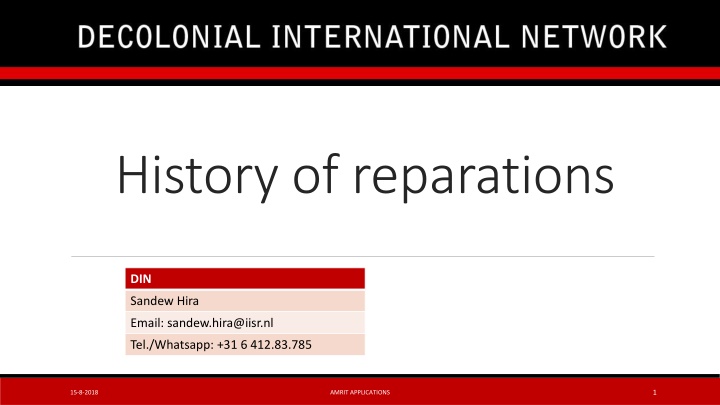


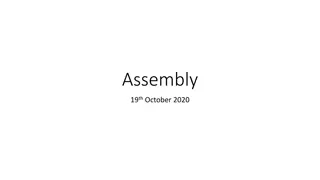
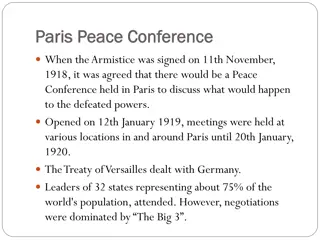
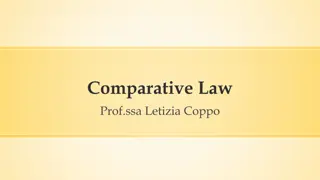
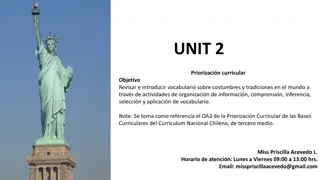
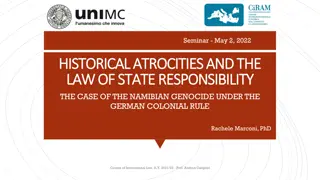
![ANC Women's League Oral Submission on Expropriation Bill [B23.2020]](/thumb/136076/anc-women-s-league-oral-submission-on-expropriation-bill-b23-2020.jpg)

